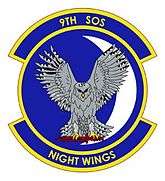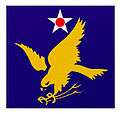9th Special Operations Squadron
9th Special Operations Squadron
 | |
|---|---|
|
Squadron MC-130P takes off during Operation Nimble Response | |
| Active | 1944–1948; 1951–1963; 1967–1972; 1988–present |
| Country |
|
| Branch |
|
| Type | Special Operations |
| Part of | Air Force Special Operations Command |
| Garrison/HQ | Cannon Air Force Base |
| Nickname(s) | Night Wings |
| Engagements | Pacific Theater of Operations Vietnam War |
| Decorations |
Distinguished Unit Citation Gallant Unit Citation Air Force Outstanding Unit Award with Combat "V" Republic of Vietnam Gallantry Cross with Palm |
| Insignia | |
| 9th Special Operations Squadron emblem (Approved 7 July 1988)[1] |
 |
The 9th Special Operations Squadron is part of the 27th Special Operations Wing (27 SOW) at Cannon Air Force Base, New Mexico. The squadron operates MC-130J Commando II aircraft in support of special operations. The 9th SOS specializes in the use of night vision goggles and formation tactics to refuel large helicopter and tilt-rotor formations. On 9 December 2014, the 522nd SOS was re-flagged as the 9th SOS moved from its location at Hurlburt Field to join the 27 SOW at Cannon Air Force Base.
Mission
Clandestine penetration of enemy territory using low-level formation procedures to provide aerial refueling of special operations helicopters and the insertion, extraction, and resupply of special operations forces by low or high altitude airdrop or airland operations.[2]
History
B-29 Superfortress operations against Japan

Activated on 1 April 1944 as a Boeing B-29 Superfortress Very Heavy bombardment squadron. When training was completed moved to North Field Tinianin the Mariana Islands of the Central Pacific Area in January 1945 and assigned to XXI Bomber Command, Twentieth Air Force. Its mission was the strategic bombardment of the Japanese Home Islands and the destruction of its war-making capability.
Flew "shakedown" missions against Japanese targets on Moen Island, Truk, and other points in the Carolines and Marianas. The squadron began combat missions over Japan on 25 February 1945 with a firebombing mission over Northeast Tokyo. The squadron continued to participate in wide area firebombing attack, but the first ten-day blitz resulting in the Army Air Forces running out of incendiary bombs. Until then the squadron flew conventional strategic bombing missions using high explosive bombs.
The squadron continued attacking urban areas with incendiary raids until the end of the war in August 1945, attacking major Japanese cities, causing massive destruction of urbanized areas. Also conducted raids against strategic objectives, bombing aircraft factories, chemical plants, oil refineries, and other targets in Japan. The squadron flew its last combat missions on 14 August when hostilities ended. Afterwards, its B 29s carried relief supplies to Allied prisoner of war camps in Japan and Manchuria
Squadron remained in Western Pacific, assigned to Twentieth Air Force on Okinawa. Maintained as a strategic bombardment squadron until inactivated due to budget reductions in late 1948. Some aircraft scrapped on Tinian; others flown to storage depots in the United States.[1]
Strategic Air Command
Reactivated in 1951 as a result of the expansion of the Air Force after the breakout of the Cold War. Initially equipped with second-line B-29 Superfortress medium bombers for training; redesignated as a heavy bomb squadron in 1952 and equipped with new Convair B-36 Peacemaker intercontinental strategic bombers. Initially was equipped with B-36Fs. Later Featherweight III B-36Js were added, the squadron operating both types. Carried red stripe on the tip of the vertical stabilizer; the lip of the jet intakes and the "nose cone" of the jet itself along with triangle-R tail code. SAC eliminated tail codes in 1953. In 1957 the B-36s were replaced with B-52E Stratofortress aircraft and all squadron markings were eliminated. While retaining combat capability, the 9th trained B-52 crews for Strategic Air Command from 15 July 1959 – September 1963. Remained equipped with the B-52s until the closure of Walker AFB in 1967.
Viet Nam

Consolidated with the Vietnam Era 9th Air Commando Squadron (Psychological Operations) in 1985. The 9th ACS operated primarily C-47 Skytrains over South Vietnam from March 1967 to January 1972. The squadron's psychological warfare missions directly or indirectly influenced the surrender of thousands of enemy soldiers. In addition, carried out night combat operations against enemy forces and hamlets through flare drops. Despite the often heavy and accurate enemy antiaircraft fire, used light observation aircraft to perform search and rescue missions to locate and direct recovery forces finding downed airmen over enemy-controlled territory. Inactivated in 1972 as part of the drawdown of forces in Indochina.[1]
Reactivated in 1988 as a special operations unit, the squadron has trained for special operations, refueling and resupply missions using modified C-130 aircraft. It has seen combat in Panama, 20 December 1989 – 14 January 1990 and Southwest Asia, 16 January 1991 – 5 April 1991. It routinely deployed personnel and aircraft to contingency operations in the Balkans and Southwest Asia from, 1991–2001. The squadron has participated in combat operations in Afghanistan since October 2001 and Iraq since March 2003.[2]
Operations and decorations
- Combat Operations: Combat in Western Pacific, 27 Jan-14 Aug 1945. Combat in Southeast Asia, Mar 1967 – Jan 1972. Performed special operations, day or night aerial refueling, infiltration/exfiltration and resupply missions using modified C-130 aircraft, 1988–. Combat in Panama, 20 Dec 1989-14 Jan 1990 and Southwest Asia, 16 Jan-5 Apr 1991. After the 11 Sep 2001 terrorist attack on the US, served on the forefront of Global War on Terrorism in Iraq and Afghanistan, 2001–.
- Campaigns: World War II: Eastern Mandates; Western Pacific; Air Offensive, Japan. Vietnam: Vietnam Air Offensive; Vietnam Air Offensive, Phase II; Vietnam Air Offensive, Phase III; Vietnam Air/Ground; Vietnam Air Offensive, Phase IV; TET 69/Counteroffensive; Vietnam Summer-Fall, 1969; Vietnam Winter-Spring, 1970; Sanctuary Counteroffensive; Monsoon; Commando Hunt V; Commando Hunt VI; Commando Hunt VII. Southwest Asia: Defense of Saudi Arabia; Liberation and Defense of Kuwait.
- Armed Forces Expeditionary Streamers. Panama, 1989–1990.
- Decorations: Distinguished Unit Citations: Tokyo, Japan, 25 May 1945; Japanese Empire, 9–19 Jul 1945. Presidential Unit Citations: Vietnam, 1–7 Mar 1967; Vietnam, 21 Jun 1968 – 30 Jun 1969. Air Force Outstanding Unit Awards with Combat "V" device: 16 Jun 1967 – 20 Jun 1968; 1 Jul 1970 – 30 Jun 1971; 1 Jun 1997 – 31 May 1999; 1 Jul 2003 – 30 Jun 2005. Gallant Unit Citation: 6 Oct 2001 – 30 May 2003. Air Force Outstanding Unit Awards: 1 May 1960 – 31 May 1962; 1 May 1988 – 30 Apr 1990; 16 Apr 1992 – 15 Apr 1994; 1 Jun 1995 – 31 May 1997; 1 Jul 1999 – 30 Jun 2001; 1 Jul 2001 – 30 Jun 2003; 1 Sep 2004 – 31 Aug 2006. Republic of Vietnam Gallantry Cross with Palm: [Mar] 1967-1 Aug 1968; 16 Jun 1967–[9 Jan] 1972; 1 Jan-30 Aug 1968; 5 Oct 1971–[9] Jan 1972.
Lineage
- 39th Bombardment Squadron
- Constituted as the 39th Bombardment Squadron, Very Heavy on 28 March 1944
- Activated on 1 April 1944
- Inactivated on 18 October 1948
- Redesignated 39th Bombardment Squadron, Medium on 20 December 1950
- Activated on 2 January 1951
- Redesignated 39th Bombardment Squadron, Heavy on 16 June 1952
- Discontinued and inactivated on 15 September 1963
- Consolidated with the 9th Special Operations Squadron as the 9th Special Operations Squadron on 19 September 1985[1]
- 9th Special Operations Squadron
- Constituted as the 9th Air Commando Squadron (Psychological Operations) and activated on 9 January 1967 (not organized)
- Organized on 25 January 1967
- Redesignated 9th Special Operations Squadron on 1 August 1968
- Inactivated on 29 February 1972
- Consolidated with the 39th Bombardment Squadron on 19 September 1985
- Activated on 1 March 1988[1]
Assignments
- 6th Bombardment Group, 1 April 1944 – 18 October 1948
- 6th Bombardment Group, 2 January 1951
- 6th Bombardment Wing (later, 6 Strategic Aerospace Wing), 16 June 1952 – 15 September 1963
- Pacific Air Forces, 9 January 1967 (not organized)
- 14th Air Commando Wing (later 14 Special Operations Wing), 25 January 1967
- 315th Tactical Airlift Wing, 30 September 1971
- 377th Air Base Wing, 15 January 1972 – 29 February 1972
- 39th Special Operations Wing, 1 March 1988
- 1st Special Operations Wing, 18 April 1989
- 1st Special Operations Group, 22 September 1992 – 8 December 2014[1]
- 27th Special Operations Group, 9 December 2014 - Present
Stations
|
|
Aircraft
|
|
See also
- List of United States Air Force special operations squadrons
- List of C-130 Hercules operators
- List of C-47 Skytrain operators
- List of B-52 Units of the United States Air Force
- List of B-29 Superfortress operators
References
Notes
- 1 2 3 4 5 6 7 8 Robertson, Patsy (March 17, 2015). "Factsheet 9 Special Operations Squadron (AFSOC)". Air Force Historical Research Agency. Retrieved March 10, 2016.
- 1 2 "Factsheet 9th Special Operations Squadron". 1st Special Operations Wing Public Affairs. July 28, 2008. Archived from the original on 20 February 2013. Retrieved March 10, 2016.
Bibliography
![]() This article incorporates public domain material from the Air Force Historical Research Agency website http://www.afhra.af.mil/.
This article incorporates public domain material from the Air Force Historical Research Agency website http://www.afhra.af.mil/.
- Maurer, Maurer, ed. (1983) [1961]. Air Force Combat Units of World War II (PDF) (reprint ed.). Washington, DC: Office of Air Force History. ISBN 0-912799-02-1. LCCN 61060979.
- Maurer, Maurer, ed. (1982) [1969]. Combat Squadrons of the Air Force, World War II (PDF) (reprint ed.). Washington, DC: Office of Air Force History. ISBN 0-405-12194-6. LCCN 70605402. OCLC 72556.


.png)
